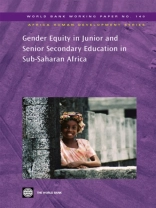This thematic study consists of case studies of Ghana, Malawi, and Uganda, as well as, a review of studies undertaken over the past ten years on education in Africa with particular attention to girls’ and secondary education. Gender equity at the primary level has been the focus of considerable attention within the Education for All Framework of Action, but much less so at the secondary level. Evidence of gender inequity and inequality in terms of access, retention and performance in secondary education in SSA raises many questions. While transition rates from primary to secondary are higher for girls than boys, and the repetition rates are lower, girls still significantly trail behind boys in graduation and enrollment rates. The purpose of this study is to document and analyze the extent and nature of gender disadvantage in junior and senior secondary education, to analyze the causes of this disadvantage, and to identify strategies that may be effective in reducing or eliminating it.This study was prepared as part of the Secondary Education and Training in Africa (SEIA) initiative which aims to assist countries to develop sustainable strategies for expansion and quality improvements in secondary education and training. All SEIA products are available on its website: www.worldbank.org/afr/seia.
World Bank
Gender Equity in Junior and Senior Secondary Education in Sub-Saharan Africa [EPUB ebook]
Gender Equity in Junior and Senior Secondary Education in Sub-Saharan Africa [EPUB ebook]
购买此电子书可免费获赠一本!
语言 英语 ● 格式 EPUB ● ISBN 9780821375068 ● 出版者 The World Bank ● 发布时间 2008 ● 下载 3 时 ● 货币 EUR ● ID 5845304 ● 复制保护 Adobe DRM
需要具备DRM功能的电子书阅读器












